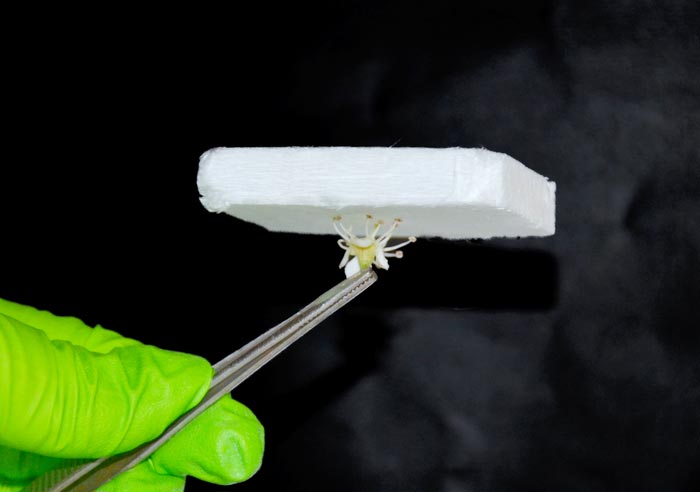
Wood-Based Insulation Outperforms Plastic for Eco-Friendly Buildings

A piece of wood aerogel 5cm x 4cm, and 1 cm thick, held aloft atop a flower.Wood aerogel for insulation
Credit: Jonas Garemark/Wallenberg Wood Science Center, KTH Royal Institute of Technology
… than existing plastic-based materials.
One day soon, buildings could become more energy-efficient—and environmentally sustainable—with insulating material developed from wood by researchers in Sweden. The newly-developed material offers as good or even better thermal performance than ordinary plastic-based insulation materials, according to researchers reporting recently in ACS Applied Materials & Interfaces.Yuanyuan Li, an assistant professor at Wallenberg Wood Science Center, KTH Royal Institute of Technology in Stockholm, says that the new insulating material is an aerogel integrated wood which is made without adding additional substances.
Wood cellulose aerogels themselves are nothing new—researchers have been developing advanced types of aerogels and other composites for the last several years in the Wallenberg Wood Science Center at KTH—but Li says the new method represents a breakthrough in controlled creation of insulating nanostructures in the pores of wood.
“Biobased strong aerogels could be used to replace current fossil-based aerogels for super thermal insulation, contributing to energy efficiency, bioeconomy, and sustainable society development,” Li says.
The process starts with delignifying the wood—that is, removing the lignin which gives wood its color and strength, leaving behind empty pores or lumen. Reducing thermal conductivity in the material is done by taking the next step—getting inside these large empty pores and generating more nano pores inside of them—thousands of them, in fact.
These nanoporous structures are created by partial dissolution of the cell walls followed by controlled precipitation, she says. An ionic liquid (IL) mixture is added to partially dissolve the cell wall before water is added, which generates nanofibril networks that render the lumen nanoporous.
Li says the researchers developed a high level of control over the precipitation process, which means they can create the precise level of nanoporosity to achieve ideal thermal conductivity.
Building insulation isn’t the only potential use for the aerogel. Li says the unique structure enables advanced materials for energy storage and conversion, and even tissue engineering. “In packaging, for example, plastic foam such as polystyrene helps prevent heat transfer between objects and the surrounding environment, so it can keep goods cool during the shipment,” she says.
“But in situ formation of nanofibril networks inside wood’s empty spaces can result in wood being highly thermal insulating.”
The work is supported by Vetenskapsrådet, Knut and Alice Wallenberg Foundation through Wallenberg Wood Science Center, Tandem Forest Values research program, European Research Council, and Treesearch through the Research Infrastructure access program.
Journal: ACS Applied Materials & Interfaces
DOI: 10.1021/acsami.2c04584
Article Title: Nanostructurally Controllable Strong Wood Aerogel toward Efficient Thermal Insulation
Article Publication Date: 5-May-2022
COI Statement: The authors declare no competing financial interest.
Media Contact
David Callahan
KTH, Royal Institute of Technology
callahan@kth.se
Office: 0737650593












